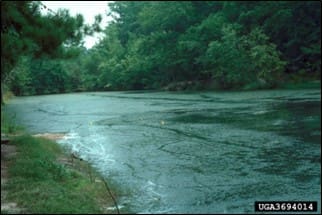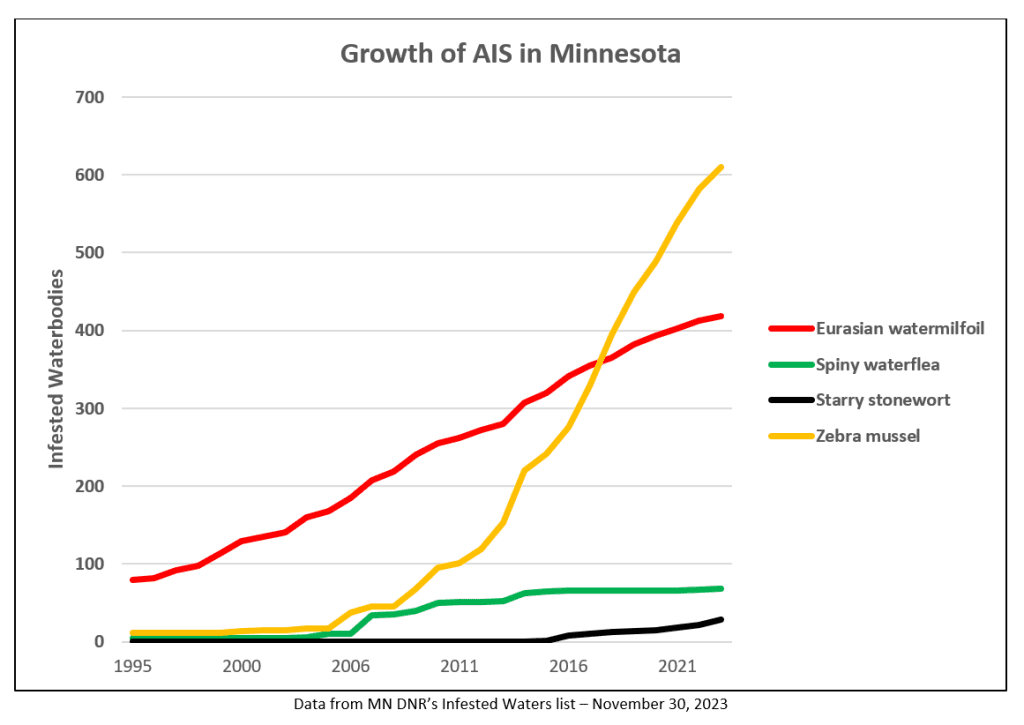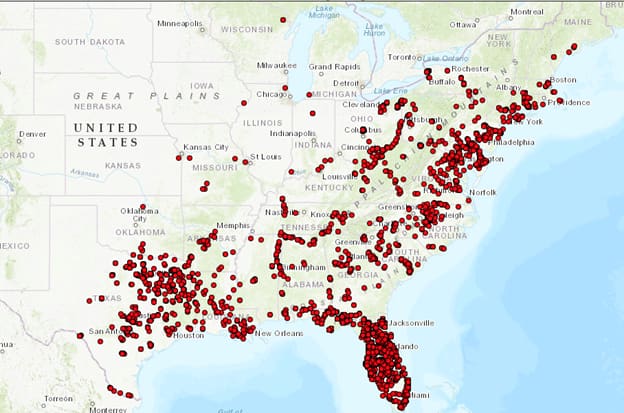
AIS continues to spread in MN and more species are on the way. You’ve heard that before, but it remains the case as we start 2024. Each year we get more infestations of species already discovered in MN and there are new species on the way. Read on to find out to learn more about the growth of AIS in MN, and what’s coming soon to a lake near you.
Also, there are three educational events listed below focused on AIS topics.
The chart below for four key aquatic invasive species is current as of January 17, 2024. Zebra mussels and spiny waterfleas are highlighted as they have significant impacts on the ecology of the water with corresponding impacts to the fish food chain. Starry stonewort and Eurasian watermilfoil are highlighted because they impact the navigation and therefore the ability to recreate on the lake. This simple growth chart, from MN DNR data as of November 30, 2023, provides some good news and bad.
The good news is that spiny waterflea infestations have leveled out and the growth rate for Eurasian watermilfoil infestations is slowing
The bad news is that zebra mussel infestations keep climbing and although not in the same league as the others, starry stonewort infestations are growing.

But more AIS is still on its way to MN and could be here already, but we haven’t yet identified it as such. The damage from most of the incoming AIS are “typical of invasives” in that they displace native species and may negatively change the ecology of the water. But one of these future invaders is debilitating to recreation on the water, and that is hydrilla.
Hydrilla roots in the lakebed and has long stems (up to 25 feet in length) that branch at the surface forming dense mats making boating very difficult. As noted by the U.S. Fish and Wildlife Service: “Hydrilla is an aquatic plant that has earned the illustrious title world’s worst invasive aquatic plant”. While not yet in Minnesota, hydrilla infestations are extensive in Florida where it was unintentionally introduced, then the infestations traveled up the eastern part of the US, with major infestations found in New York.

And hydrilla is also heading north into the Midwest. In 2023, Hydrilla was found in Berrien County in southwestern Michigan, in the town of Crystal Lake in northeastern Illinois, and in the Mississippi River near Davenport, Iowa.
Here is a current map of hydrilla infestations in the central and eastern US.

A recent NY Times article reported on the hydrilla challenges faced on the Connecticut River, the longest river in New England as they try to contain it from moving to 4 other states. Transmission through rivers makes control very challenging and boater movement between infested rivers and lakes brings the invasive inland. Connecticut has given up on eradication and hope to beat the infestation back year after year with herbicides and education. Sound familiar? They are also working with the U.S. Army Engineer Research and Development Center on a novel approach using red tracer dye to help find the right dosage of herbicides to kill the hydrilla and not hurt the native plants.
So, if there is any one take-away from this update on AIS, it is that you should not let your guard down. Protect the lakes and river you love as best you can. Push the MN Legislature to do more, push the MN DNR to do more, push your local government units to do more, push your lake and river associations to do more, and push your friends and neighbors to do more!
